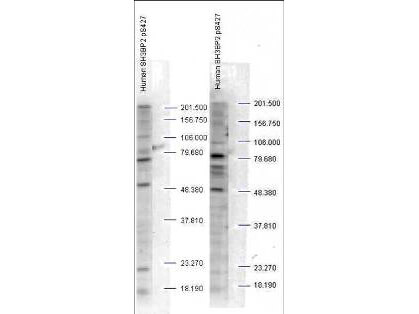Anti-SH3BP2 pS427 (RABBIT) Antibody
SH3BP2 phospho S427 Antibody
- SPECIFICATION
- CITATIONS
- PROTOCOLS
- BACKGROUND

| Host | Rabbit |
|---|---|
| Conjugate | Unconjugated |
| Target Species | Human |
| Reactivity | Rat, Human, Mouse |
| Clonality | Polyclonal |
Application
| WB, E, IP, I, LCI |
| Application Note | This affinity purified antibody has been tested for use in ELISA and by western blot. Specific conditions for reactivity should be optimized by the end user. Expect a band approximately 60 kDa in size corresponding to SH3BP2 by western blotting in the appropriate cell lysate or extract. |
| Physical State | Liquid (sterile filtered) |
| Buffer | 0.02 M Potassium Phosphate, 0.15 M Sodium Chloride, pH 7.2 |
| Immunogen | This affinity purified antibody was prepared from whole rabbit serum produced by repeated immunizations with a synthetic peptide corresponding to an internal region near aa 415-440 of Human SH3BP3 protein (SH3 Domain Binding Protein 2). |
| Preservative | 0.01% (w/v) Sodium Azide |
| Gene ID | 6452 |
|---|---|
| Other Names | 10825 |
| Purity | This product is an affinity purified antibody produced by immunoaffinity chromatography and is phospho specific for human pS427. |
| Storage Condition | Store vial at -20° C prior to opening. Aliquot contents and freeze at -20° C or below for extended storage. Avoid cycles of freezing and thawing. Centrifuge product if not completely clear after standing at room temperature. This product is stable for several weeks at 4° C as an undiluted liquid. Dilute only prior to immediate use. |
| Precautions Note | This product is for research use only and is not intended for therapeutic or diagnostic applications. |
| Name | SH3BP2 |
|---|---|
| Synonyms | 3BP2 |
| Function | Binds differentially to the SH3 domains of certain proteins of signal transduction pathways. Binds to phosphatidylinositols; linking the hemopoietic tyrosine kinase fes to the cytoplasmic membrane in a phosphorylation dependent mechanism. |
| Tissue Location | Expressed in a variety of tissues including lung, liver, skeletal muscle, kidney and pancreas |

Thousands of laboratories across the world have published research that depended on the performance of antibodies from Abcepta to advance their research. Check out links to articles that cite our products in major peer-reviewed journals, organized by research category.
info@abcepta.com, and receive a free "I Love Antibodies" mug.
Provided below are standard protocols that you may find useful for product applications.
Background
SH3BP2 Src Homology 3 Binding Protein 2 is also known as 3BP-2 and SH3 Binding Protein 2. The Src homology 3 (SH3) region is a small protein domain presented in a very large group of proteins, including cytoskeletal elements and signaling proteins. SH3 domains are believed to serve as modules that mediate protein-protein associations and, along with Src homology 2 (SH2) domains, regulate cytoplasmic signaling. SH3BP2 is composed of an N terminal pleckstrin homology (PH) domain, a ten aa SH3 binding domain, three modular peptide recognition domains, and a C terminal SH2 domain. SH3BP2 function relates to signal transduction and regulation. SH3BP2 binds differentially to the SH3 domains of certain proteins of signal transduction pathways. Phosphorylation of SH3BP2 occurs on S427 for activation. SH3BP2 mediates interactions of huntingtin and MLK2 (mixed lineage kinase). Defects in SH3BP2 are the cause of cherubism (CRBM), an autosomal dominant inherited syndrome. It is characterized by excessive bone degradation of the upper and lower jaws, which often begins around three years of age. It is followed by development of fibrous tissue masses, which causes a characteristic facial swelling.
If you have used an Abcepta product and would like to share how it has performed, please click on the "Submit Review" button and provide the requested information. Our staff will examine and post your review and contact you if needed.
If you have any additional inquiries please email technical services at tech@abcepta.com.













 Foundational characteristics of cancer include proliferation, angiogenesis, migration, evasion of apoptosis, and cellular immortality. Find key markers for these cellular processes and antibodies to detect them.
Foundational characteristics of cancer include proliferation, angiogenesis, migration, evasion of apoptosis, and cellular immortality. Find key markers for these cellular processes and antibodies to detect them. The SUMOplot™ Analysis Program predicts and scores sumoylation sites in your protein. SUMOylation is a post-translational modification involved in various cellular processes, such as nuclear-cytosolic transport, transcriptional regulation, apoptosis, protein stability, response to stress, and progression through the cell cycle.
The SUMOplot™ Analysis Program predicts and scores sumoylation sites in your protein. SUMOylation is a post-translational modification involved in various cellular processes, such as nuclear-cytosolic transport, transcriptional regulation, apoptosis, protein stability, response to stress, and progression through the cell cycle. The Autophagy Receptor Motif Plotter predicts and scores autophagy receptor binding sites in your protein. Identifying proteins connected to this pathway is critical to understanding the role of autophagy in physiological as well as pathological processes such as development, differentiation, neurodegenerative diseases, stress, infection, and cancer.
The Autophagy Receptor Motif Plotter predicts and scores autophagy receptor binding sites in your protein. Identifying proteins connected to this pathway is critical to understanding the role of autophagy in physiological as well as pathological processes such as development, differentiation, neurodegenerative diseases, stress, infection, and cancer.


